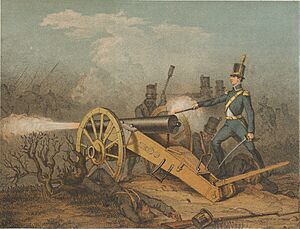Battle of Lappfjärd facts for kids
Quick facts for kids Battle of Lappfjärd |
|||||||
|---|---|---|---|---|---|---|---|
| Part of the Finnish War | |||||||
 Dispositions at the battle |
|||||||
|
|||||||
| Belligerents | |||||||
| Commanders and leaders | |||||||
| Strength | |||||||
| 5,400 15 guns |
2,150 6 guns |
||||||
| Casualties and losses | |||||||
| 113 killed or wounded | 153 killed or wounded 82 captured |
||||||
The Battle of Lappfjärd was a fight between Swedish and Russian armies. It happened in Lappfjärd, Finland, on August 29, 1808. This battle was part of the larger Finnish War.
Contents
What Led to the Battle of Lappfjärd?
General Bibikov, a Russian commander, was stationed at Ömossa, south of Lappfjärd. He heard that another Russian attack had happened at Nummijärvi. Bibikov decided to attack the Swedish troops at Lappfjärd.
Bibikov's Plan
General Bibikov believed his army was larger than the Swedish forces. He had about 2,150 soldiers. He thought he could easily win the battle. However, he did not know that a much larger Swedish force was waiting for him.
The Swedish Army Arrives
On August 28, 1808, Swedish General Eberhard von Vegesack landed at Kristinestad. He brought 3,000 new soldiers with him. He then took command of the Swedish troops already in Lappfjärd. This meant the Swedish army was now much bigger than Bibikov expected.
Swedish Forces at Lappfjärd
The Swedish army under General von Vegesack had a total of 5,400 soldiers. They also had 15 cannons. This force included many different types of units. There were infantry regiments like the Björneborg, Hälsinge, and Uppland Infantry. They also had cavalry (soldiers on horseback) and artillery (cannons).
The Battle Begins
On August 29, the Russian army, led by General Bibikov, attacked the Swedes. The Russians had 2,150 men and six cannons. The Swedish army, though much larger, did not use all its soldiers in the fight.
Fighting at Lappfjärd
The Russians tried to break through the Swedish lines. They attacked the sides of the Swedish army, but they could not succeed. The fighting lasted for four hours. The Swedish defenses held strong.
Swedish Counterattack and Retreat
After four hours of fighting, the Swedish commander ordered his troops to attack back. This counterattack forced the Russian soldiers to retreat. The battle ended with a Swedish victory.
Battle Results
The Russians lost 153 soldiers who were either killed or wounded. Another 82 Russian soldiers were captured by the Swedes. The Swedish army had fewer losses, with 113 soldiers killed or wounded.
What Happened After the Battle?
After the battle, General von Vegesack realized he had thought the Russian army was stronger than it actually was. Because of this, he did not completely defeat them.
The Skirmish at Ömossa
A Swedish outpost was set up at Ömossa. It had one battalion of soldiers from the Uppland Infantry Regiment and two cannons. This outpost was led by Wilhelm von Schwerin. On September 6, General Bibikov attacked this outpost with 1,500 men and six cannons.
The Swedes fought bravely and pushed back several Russian attacks. Even the Cossack Life Guards Regiment, a special Russian unit, was stopped. However, the Swedes were eventually forced to retreat. They lost 64 soldiers who were killed or wounded. Thanks to Schwerin's strong defense, the Swedes were able to retreat in an organized way.
The main Swedish army then went on to fight the Battles of Ruona and Salmi a few days later. These battles greatly affected Sweden's efforts in the Finnish War.


